Recycled Carbon Fibers with Improved Physical Properties Recovered from CFRP by Nitric Acid
Abstract
:1. Introduction
2. Materials and Methods
2.1. Materials
2.1.1. CFRP Samples
2.1.2. Epoxy Resin Decomposition and Recovery of Recycled Carbon Fibers and Resins
2.1.3. Immersion of Virgin Carbon Fibers in Nitric Acid
2.2. Methods
2.2.1. Time Change of Epoxy Resin Decomposition Ratio
2.2.2. Interfacial Shear Strength between Carbon Fiber and Resin
2.2.3. Tensile Strength Test of Single Carbon Fiber
2.2.4. Analysis of Carbon Fiber Surface and Cross Section
3. Results
3.1. Time Change of Resin Decomposition in CFRP Specimen
3.2. Interfacial Shear Strength between Carbon Fiber and Resin
3.3. Tensile Strength of Carbon Fiber
3.4. Shape Observation of Carbon Fiber Surface
3.5. Elemental Distribution on Carbon Fiber Surface
3.6. Structure and Elemental Distribution of Carbon Fiber Cross-Section
3.7. Observation of Graphite Structure by Laser Raman Spectrum Measurement
4. Discussion
4.1. Mechanism of the Improvement of Interfacial Shear Strength between Carbon Fiber and Resin
4.2. The Mechanism of the Improvement of Tensile Strength of Carbon Fiber
5. Conclusions
- (1)
- The interfacial shear strength between the rCF and the resin was higher than that of vCF due to the formation of new polar functional groups on the carbon fiber surface due to nitric acid. This study found that, upon controlling the length of recycling time to 12–24 h, the interfacial shear strength was maximized to 2.2 times that of the vCF. Furthermore, longer immersion will oxidize the functional groups and increase the abundance of carboxy groups that have weak bonds with the resin. However, it could retain approximately the same interfacial shear strength as the vCF to which a sizing agent was applied.
- (2)
- The fiber strength of the rCF expressed a higher value than that of the vCF, with a maximum of 1.4 times than that of the vCF at rCF 12 h, due to the combined effect of the following two factors: (1) a reduction in the abundance of voids and (2) the reinforcement of the fiber strength due to the formation of new polar functional groups inside the voids by nitric acid. Furthermore, it was shown that because prolonged immersion results in defects and structural disruption of the graphite structure, the optimal recycling time for recovering the rCF with improved strength was 12 h to 72 h.
- (3)
- Elucidating the mechanism that expressed its physical properties during the recycling process made it possible to control the quality of rCF through the recycling process. Therefore, it was shown that rCF could likely be applied to CFRP products, which is a novel approach to realizing closed-loop recycling.
Author Contributions
Funding
Institutional Review Board Statement
Informed Consent Statement
Data Availability Statement
Acknowledgments
Conflicts of Interest
Appendix A


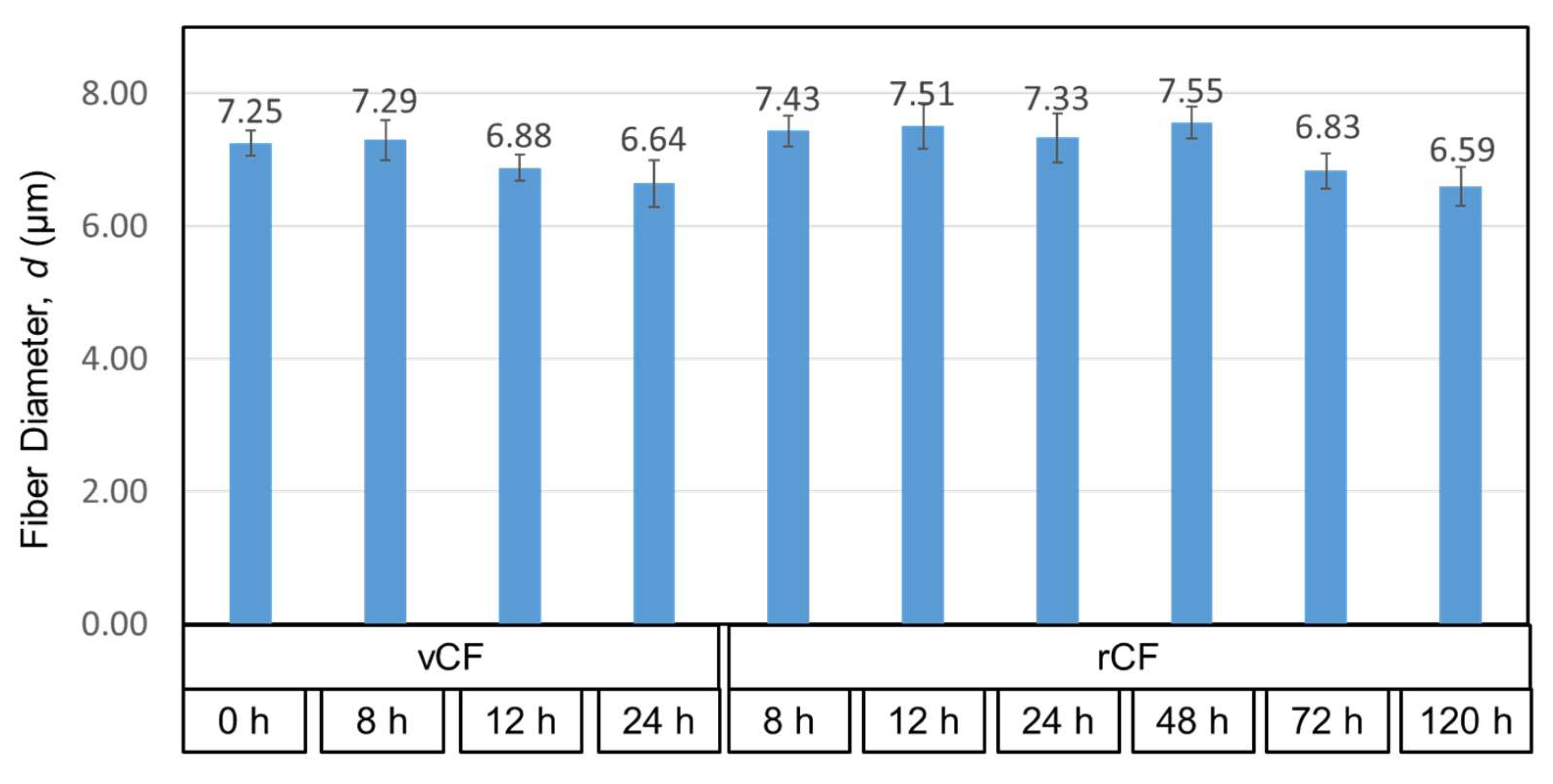
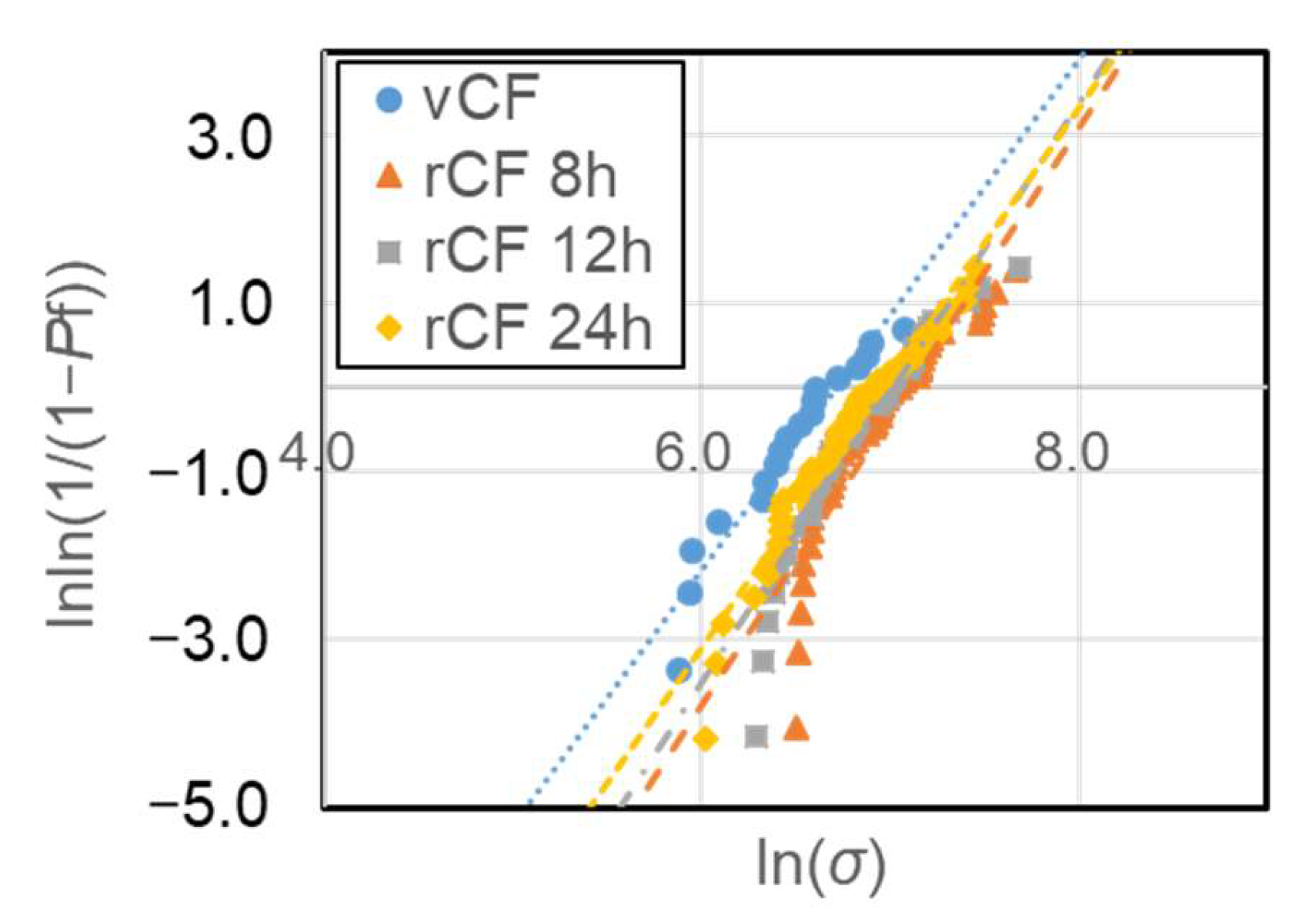
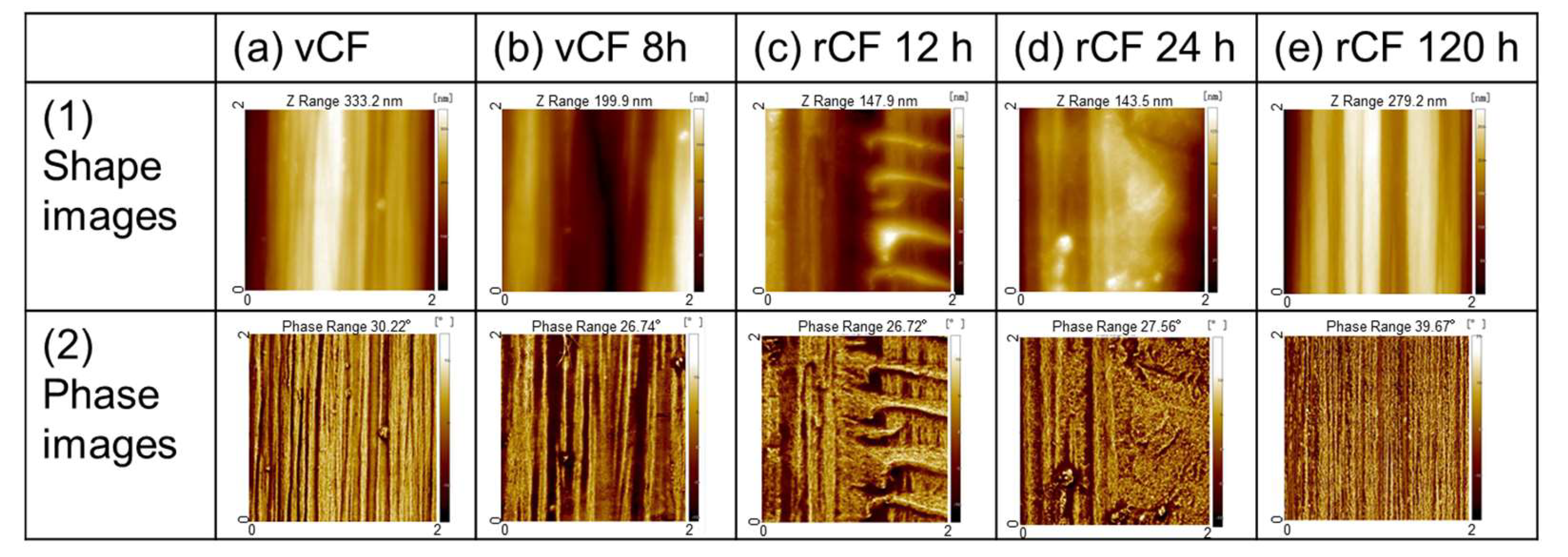
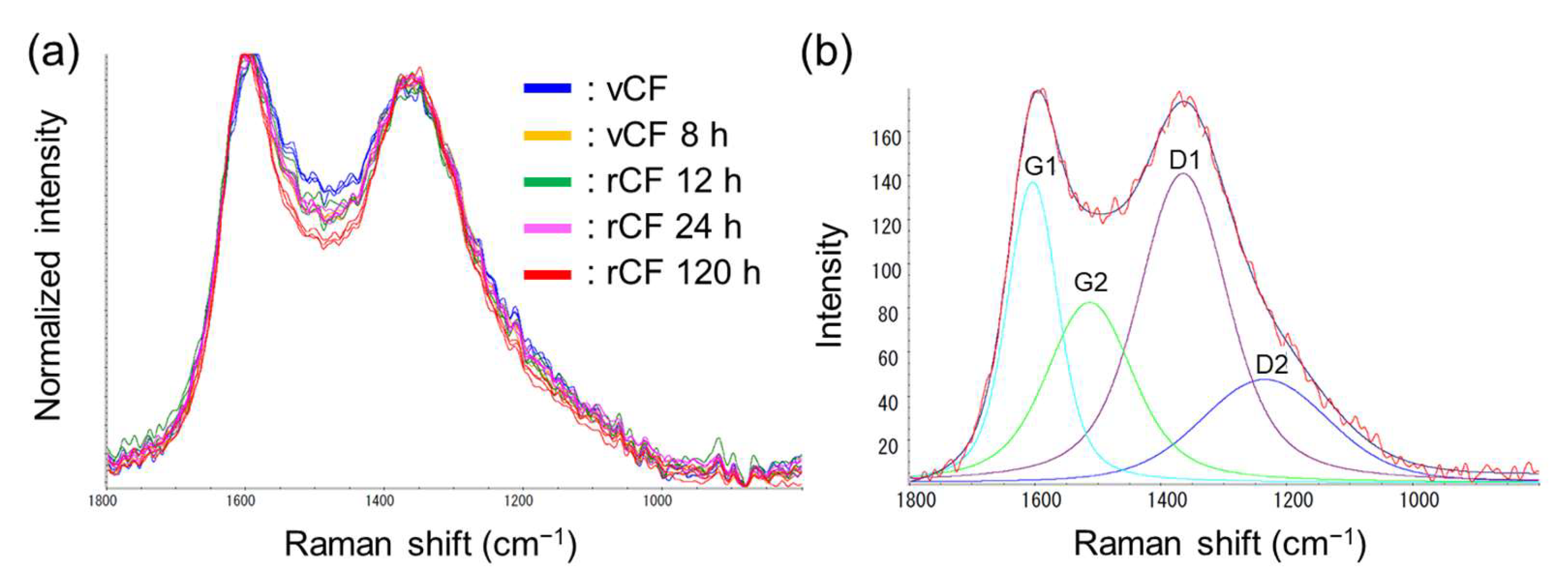
Appendix B
| Shape Factor, m | Scale Factor, σ0 (GPa) | |
|---|---|---|
| vCF | 3.27 | 0.77 |
| vCF 8 h | 3.34 | 0.99 |
| vCF 12 h | 3.18 | 0.81 |
| vCF 24 h | 3.02 | 0.70 |
| rCF 8 h | 3.43 | 0.96 |
| rCF 12 h | 3.45 | 1.05 |
| rCF 24 h | 3.21 | 1.02 |
| rCF 48 h | 3.44 | 1.02 |
| rCF 72 h | 3.04 | 1.03 |
| rCF 120 h | 3.45 | 0.60 |
References
- Yano Research Institute Ltd. Global Automotive CFRP (Carbon-Fiber-Reinforced Plastics) Market Forecast 2021; Yano Research Institute Ltd.: Tokyo, Japan, 2021; pp. 27–38. [Google Scholar]
- Lefeuvre, A.; Garnier, S.; Jacquemin, L.; Pillain, B.; Sonnemann, G. Anticipating In-Use Stocks of Carbon Fiber Reinforced Polymers and Related Waste Flows Generated by the Commercial Aeronautical Sector Until 2050. Resour. Conserv. Recycl. 2017, 125, 264–272. [Google Scholar] [CrossRef]
- FY 2015 Annual Report: New Energy and Industrial Technology Development Organization; Study of Recycling Technologies for Carbon Fiber Composite Materials Used in Automobiles: Innovative New Structural Materials R&D Project; Industrial Technology Development Organization: Tokyo, Japan, 2016; pp. 10–21.
- Ma, C.; Sánchez-Rodríguez, D.; Kamo, T. Influence of Thermal Treatment on the Properties of Carbon Fiber Reinforced Plastics Under Various Conditions. Polym. Degrad. Stab. 2020, 178, 109199. [Google Scholar] [CrossRef]
- Jiang, G.; Pickering, S.J. Structure-Property Relationship of Recycled Carbon Fibres Revealed by Pyrolysis Recycling Process. J. Mater. Sci. 2016, 51, 949–1958. [Google Scholar] [CrossRef]
- Ibarra, R.M.; Sasaki, M.; Goto, M.; Quitain, A.T.; Montes, S.M.G.; Aguilar-Garib, J.A. Carbon Fiber Recovery Using Water and Benzyl Alcohol in Subcritical and Supercritical Conditions for Chemical Recycling of Thermoset Composite Materials. J. Mater. Cycles Waste Manag. 2015, 17, 369–379. [Google Scholar] [CrossRef]
- Kim, Y.; Kim, Y.; Kim, S.; Park, M.; Yang, B.; Kim, J.; Jung, Y.C. Application of Supercritical Water for Green Recycling of Epoxy-Based Carbon Fiber Reinforced Plastic. Compos. Sci. Technol. 2019, 173, 66–72. [Google Scholar] [CrossRef]
- Okajima, I.; Watanabe, K.; Haramiishi, S.; Nakamura, M.; Shimamura, Y.; Sako, T. Recycling of Carbon Fiber Reinforced Plastic Containing Amine-Cured Epoxy Resin Using Supercritical and Subcritical Fluids. J. Supercrit. Fluids 2017, 119, 44–51. [Google Scholar] [CrossRef]
- Liu, Y.; Meng, L.; Huang, Y.; Du, J. Recycling of Carbon/Epoxy Composites. J. Appl. Polym. Sci. 2004, 94, 1912–1916. [Google Scholar] [CrossRef]
- Ma, J.H.; Wang, X.B.; Li, B.; Huang, L.N. Investigation on Recycling Technology of Carbon Fiber Reinforced Epoxy Resin Cured with Amine. Adv. Mater. Res. 2009, 79–82, 409–412. [Google Scholar] [CrossRef]
- Lee, S.-H.; Choi, H.-O.; Kim, J.-S.; Lee, C.-K.; Kim, Y.-K.; Ju, C.-S. Circulation Flow Reactor for Recycling of Carbon Fiber from Carbon Fiber Reinforced Epoxy Composites. Korean J. Chem. Eng. 2011, 28, 449–454. [Google Scholar] [CrossRef]
- Dang, W.; Kubouchi, M.; Yamamoto, S.; Sembokuya, H.; Tsuda, K. An Approach to Chemical Recycling of Epoxy Resin Cured with Amine Using Nitric Acid. Polymer 2002, 43, 2953–2958. [Google Scholar] [CrossRef]
- Hanaoka, T.; Arao, Y.; Kayaki, Y.; Kuwata, S.; Kubouchi, M. Analysis of Nitric Acid Decomposition of Epoxy Resin Network Structures for Chemical Recycling. Polym. Degrad. Stab. 2021, 186, 109537. [Google Scholar] [CrossRef]
- Hanaoka, T.; Ikematsu, H.; Takahashi, S.; Ito, N.; Ijuin, N.; Kawada, H.; Arao, Y.; Kubouchi, M. Recovery of Carbon Fiber from Prepreg Using Nitric Acid and Evaluation of Recycled CFRP. Compos. Part B 2022, 231, 109560. [Google Scholar] [CrossRef]
- Sakai, A.; Kurniawan, W.; Kubouchi, M.; Inui, M.; Mizutani, A.; Kuroda, T. Study on Kinetics of Epoxy Resin Decomposition and Evaluation of Recovered Carbon Fibers from CFRP by Nitric Acid Treatment Aiming for the Recycling of both Resin and Carbon Fibers. J. Netw. Polym. 2022, 43, 198–208. [Google Scholar]
- Kang, S.K.; Lee, D.B.; Choi, N.S. Fiber/Epoxy Interfacial Shear Strength Measured by the Microdroplet Test. Compos. Sci. Technol. 2009, 69, 245–251. [Google Scholar] [CrossRef]
- Guo, H.; Huang, Y.; Liu, L.; Shi, X. Effect of Epoxy Coatings on Carbon Fibers During Manufacture of Carbon Fiber Reinforced Resin Matrix Composites. Mater. Des. 2010, 31, 1186–1190. [Google Scholar] [CrossRef]
- Ko, T.H. Raman Spectrum of Modified PAN-Based Carbon Fibers During Graphitization. J. Appl. Polym. Sci. 1996, 59, 577–580. [Google Scholar] [CrossRef]
- Vautard, F.; Dentzer, J.; Nardin, M.; Schultz, J.; Defoort, B. Influence of Surface Defects on the Tensile Strength of Carbon Fibers. Appl. Surf. Sci. 2014, 322, 185–193. [Google Scholar] [CrossRef]
- Wu, S.; Liu, Y.; Ge, Y.; Ran, L.; Peng, K.; Yi, M. Surface Structures of PAN-Based Carbon Fibers and Their Influences on the Interface Formation and Mechanical Properties of Carbon-Carbon Composites. Compos. Part A 2016, 90, 480–488. [Google Scholar] [CrossRef]
- Sharma, M.; Gao, S.; Mader, E.; Sharma, H.; Wei, L.Y.; Bijwe, J. Carbon Fiber Surfaces and Composite Interphase. Compos. Sci. Technol. 2014, 102, 35–50. [Google Scholar] [CrossRef]
- Pittman, C.U.; He, G.R.; Wu, B.; Gardner, S.D. Chemical Modification of Carbon Fiber Surfaces by Nitric Acid Oxidation Followed by Reaction with Tetraethylenpentamine. Carbon 1997, 35, 317–331. [Google Scholar] [CrossRef]
- Rahaman, M.S.A.; Ismail, A.F.; Mustafa, A. A Review of Heat Treatment on Polyacrylonitrile Fiber. Polym. Degrad. Stab. 2007, 92, 1421–1432. [Google Scholar] [CrossRef] [Green Version]
- Yamauchi, S.; Kurimoto, Y. Raman Spectroscopic Study on Pyrolyzed Wood and Bark of Japanese Cedar: Temperature Dependence of Raman Parameters. J. Wood Sci. 2003, 49, 235–240. [Google Scholar] [CrossRef]
- Li, J.; Sun, F.F. The Effect of Surface Modification with Nitric Acid on the Mechanical and Tribological Properties of Carbon Fiber-Reinforced Thermoplastic Polyimide Composite. Surf. Interface Anal. 2009, 41, 255–258. [Google Scholar] [CrossRef]
- Zielke, U.; Huttinger, K.J.; Hoffman, W.P. Surface-Oxidized Carbon Fibers: I. Surface Structure and Chemistry. Carbon 1996, 34, 983–998. [Google Scholar] [CrossRef]
- Zhang, X.; Huang, Y.; Wang, T. Surface Analysis of Plasma Grafted Carbon Fiber. Appl. Surf. Sci. 2006, 253, 2885–2892. [Google Scholar] [CrossRef]
- Park, S.J.; Kim, B.J. Roles of Acidic Functional Groups of Carbon Fiber Surfaces in Enhancing Interfacial Adhesion Behavior. Mater. Sci. Eng. A 2005, 408, 269–273. [Google Scholar] [CrossRef]
- Noguchi, K.; Hiramatsu, T.; Higuchi, T.; Murayama, K. Fracture surface of carbon fibers. In Proceedings of the International Carbon Conference, Bordeaux, France, 2–6 July 1984; pp. 178–179. [Google Scholar]
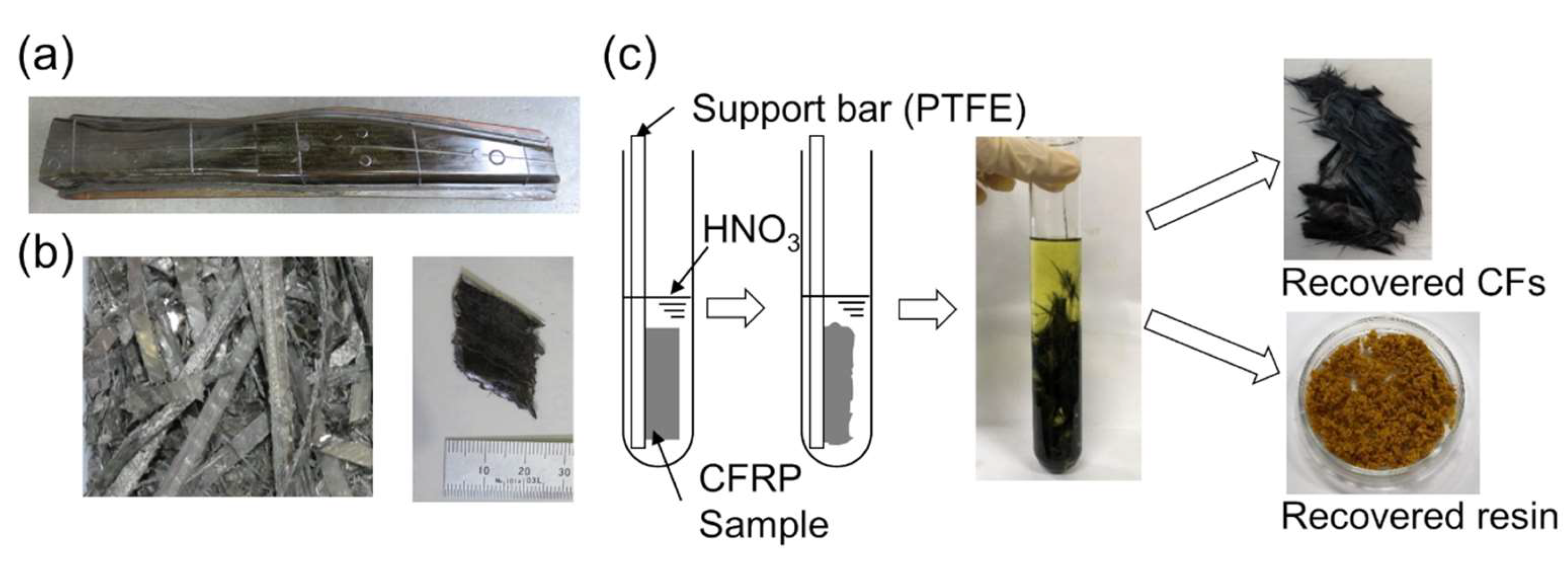


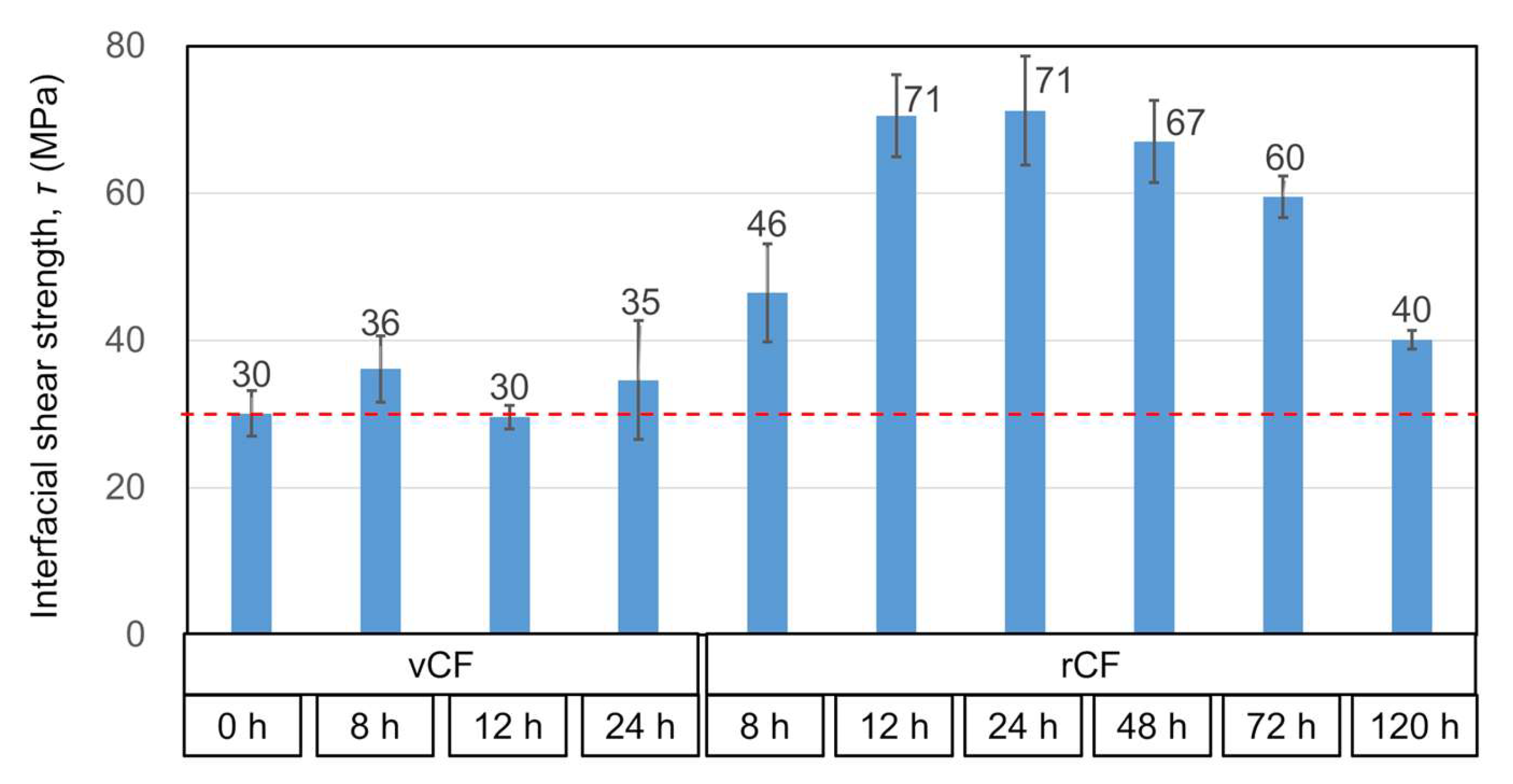
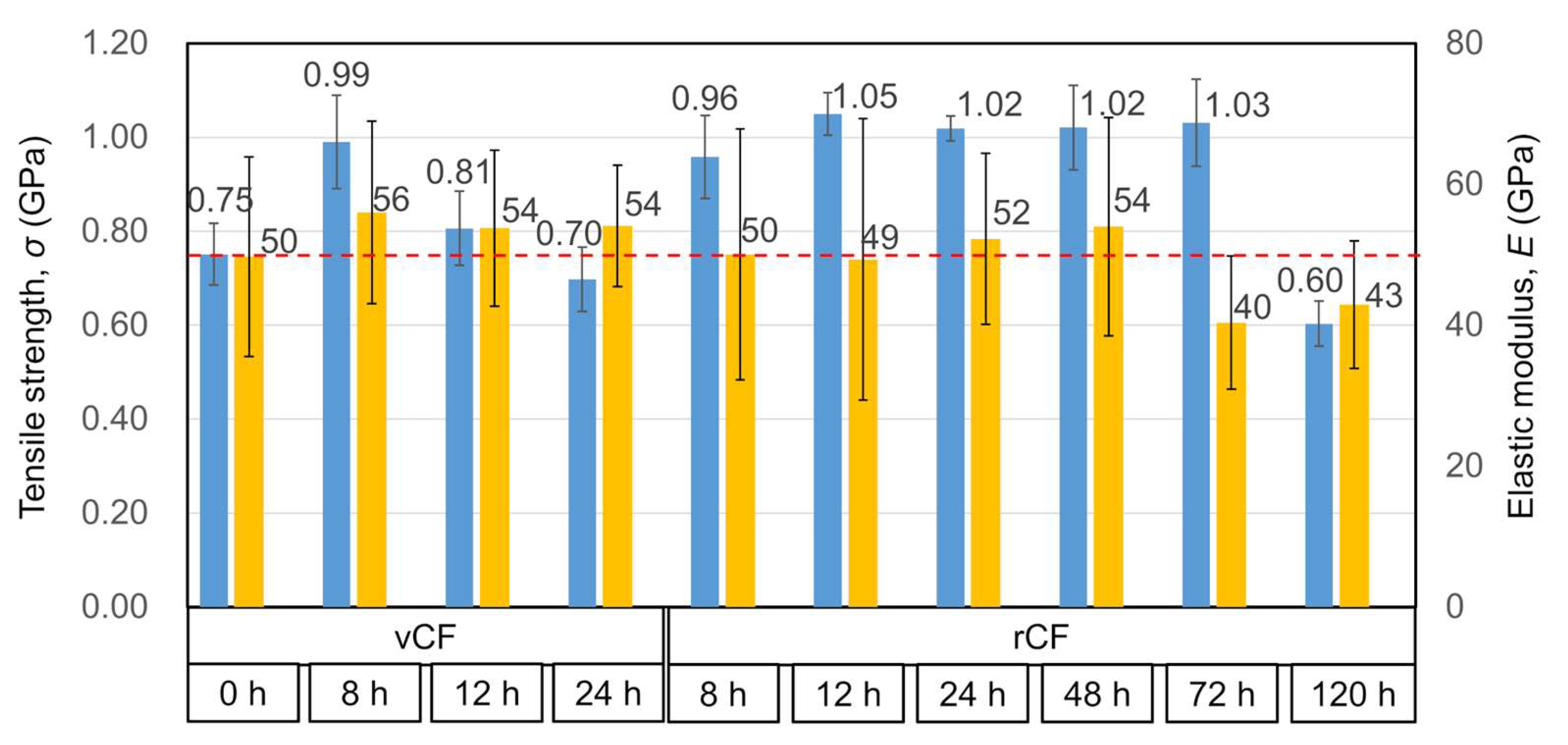
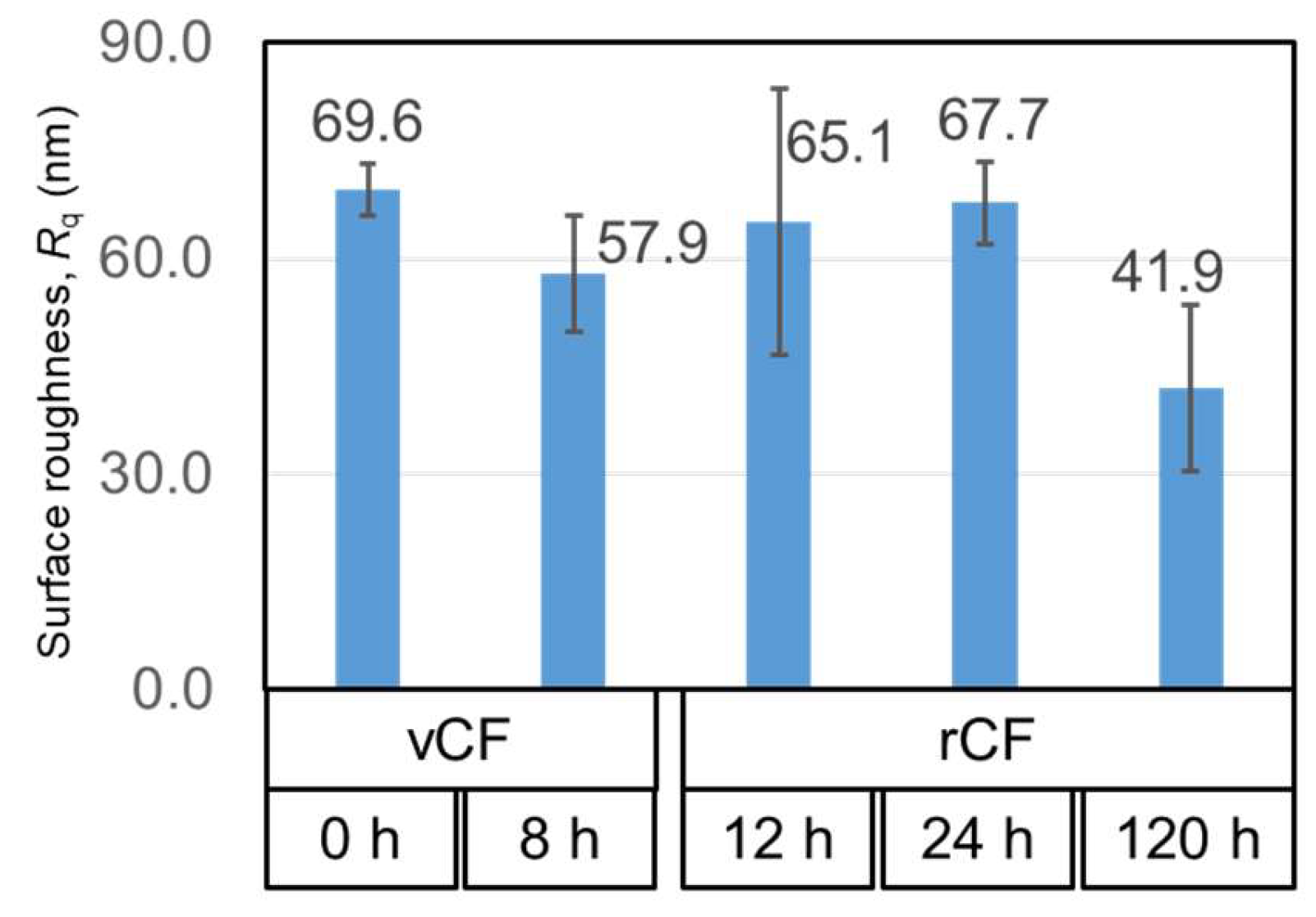
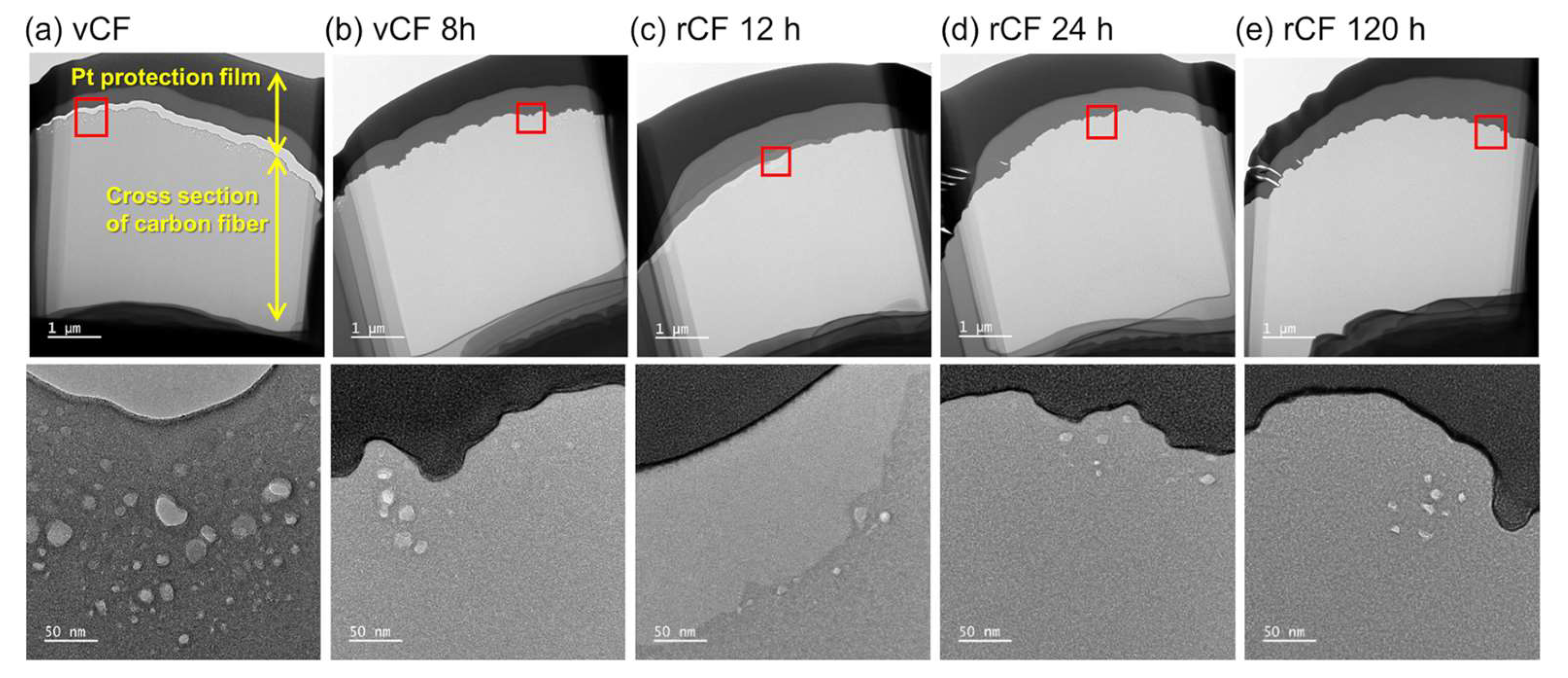


| vCF | vCF 8 h | rCF 12 h | rCF 24 h | rCF 120 h | ||
|---|---|---|---|---|---|---|
| C (%) | CHn | 45.1 | 38.1 | 30.7 | 35.8 | 42.3 |
| C-OH, C-O-C | 27.8 | 23.3 | 25.6 | 23.8 | 21.1 | |
| >C=O | 2.8 | 3.4 | 4.2 | 3.8 | 3.3 | |
| -CO-O- | 0.8 | 3.0 | 2.6 | 2.7 | 4.0 | |
| -C=C- | 0.7 | 1.9 | 1.4 | 1.5 | 2.0 | |
| Total | 77.2 | 69.7 | 64.5 | 67.5 | 72.7 | |
| N (%) | -NH2 | 0.0 | 1.4 | 1.5 | 1.1 | 1.5 |
| -NO/NH4 | 1.2 | 0.7 | 1.3 | 1.3 | 1.3 | |
| -NO2 | 0.0 | 4.2 | 6.1 | 5.5 | 3.9 | |
| Total | 1.2 | 6.2 | 8.9 | 7.9 | 6.6 | |
| O (%) | 19.5 | 22.6 | 26.8 | 24.5 | 20.5 | |
| Others (%) | 1.9 | 1.6 | 0.1 | 0.0 | 0.2 | |
| Presence Ratio of Voids | |
|---|---|
| vCF | 3.21% |
| vCF 8 h | 0.95% |
| rCF 12 h | 1.05% |
| rCF 24 h | 1.17% |
| rCF 120 h | 0.23% |
Disclaimer/Publisher’s Note: The statements, opinions and data contained in all publications are solely those of the individual author(s) and contributor(s) and not of MDPI and/or the editor(s). MDPI and/or the editor(s) disclaim responsibility for any injury to people or property resulting from any ideas, methods, instructions or products referred to in the content. |
© 2023 by the authors. Licensee MDPI, Basel, Switzerland. This article is an open access article distributed under the terms and conditions of the Creative Commons Attribution (CC BY) license (https://creativecommons.org/licenses/by/4.0/).
Share and Cite
Sakai, A.; Kurniawan, W.; Kubouchi, M. Recycled Carbon Fibers with Improved Physical Properties Recovered from CFRP by Nitric Acid. Appl. Sci. 2023, 13, 3957. https://doi.org/10.3390/app13063957
Sakai A, Kurniawan W, Kubouchi M. Recycled Carbon Fibers with Improved Physical Properties Recovered from CFRP by Nitric Acid. Applied Sciences. 2023; 13(6):3957. https://doi.org/10.3390/app13063957
Chicago/Turabian StyleSakai, Asuka, Winarto Kurniawan, and Masatoshi Kubouchi. 2023. "Recycled Carbon Fibers with Improved Physical Properties Recovered from CFRP by Nitric Acid" Applied Sciences 13, no. 6: 3957. https://doi.org/10.3390/app13063957





